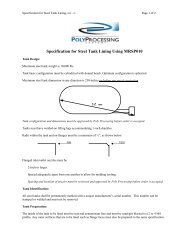Carbon Black and Plastics - Poly Processing
Carbon Black and Plastics - Poly Processing
Carbon Black and Plastics - Poly Processing
Create successful ePaper yourself
Turn your PDF publications into a flip-book with our unique Google optimized e-Paper software.
1- Introduction:Why Some Rotomolded Tanks are <strong>Black</strong> in Color<strong>Carbon</strong> <strong>Black</strong> <strong>and</strong> <strong>Plastics</strong>Prepared By: Team InnovationRotomolded tanks come in a wide variety of colors or pigments. The choice of whichcolor to use will generally depend on one, or a combination of, the following; cosmetics,customer requirements, <strong>and</strong> application or stored medium. One color that has beencontinuously specified for higher end applications, such as outside storage of sodiumhypochlorite, is black. This color is usually achieved by dry blending carbon black withthe primary powder resin prior to molding.<strong>Carbon</strong> black (CB) is a form of nearly pure, elemental carbon. It differs in molecularstructure from the more common forms of elemental carbon – graphite <strong>and</strong> diamond –<strong>and</strong> therefore also differs in physical properties. <strong>Carbon</strong> black is softer than eithergraphite or diamond <strong>and</strong> is intensely black in color, although the color does vary slightlydepending on the manner in which it is made, the contaminants that are present, <strong>and</strong>the particle size. <strong>Carbon</strong> black is manufactured by burning hydrocarbon fuels in acontrolled manner with insufficient oxygen for complete combustion. It is like the sootthat forms around the top of a glass chimney of a kerosene lantern. In fact, kerosene isthe most common hydrocarbon used in the manufacture of carbon black.<strong>Carbon</strong> black has many applications in plastics. It is used as a pigment, conductive fillermaterial, particulate reinforcement, <strong>and</strong> ultraviolet light (UV) absorber. In rotomoldedtanks CB is used both as a pigment <strong>and</strong> as an ultraviolet light absorber. <strong>Carbon</strong> blackhas proven to be the st<strong>and</strong>ard against which all other pigments, such as forest green<strong>and</strong> white, <strong>and</strong> other UV absorbers are compared.2- Weathering of <strong>Plastics</strong>:All materials absorb sunlight radiation – it’s what makes them heat up in the sunshine.While the effect of sunlight is minimal beyond just simple heating in many materials,some other materials are actually degraded by sunlight. Most plastics are in this lattergroup. Studies of the degradation of plastics by sunlight have shown that sunlight is aspectrum of frequencies <strong>and</strong> that the most destructive frequencies for plastics are thoseat the higher energy end of sunlight – in the ultraviolet range of the spectrum. Theabsorbed UV light breaks, or cleaves, the weak chemical bonds or molecular chains ofthe polymer material. This leads to shorter chains, which in turn causes the plasticmaterial to become more brittle. This process is called, photo degradation, <strong>and</strong> it leadsto loss of mechanical properties <strong>and</strong>/or discoloration, cracking, fading, <strong>and</strong> chalking. Inother words photo degradation leads to weathering of plastics.1
<strong>Poly</strong>mer Chain+ HeatPhoto DegradationSunlight Radiation (UV light)3- UV Stabilizers:In order to protect outdoor plastic products from the damaging UV light, the plasticneeds to be shielded from these harmful rays. Of course shielding from sunlight usingsome umbrella-like shading system is often impractical <strong>and</strong> could be very expensive.Therefore, a simple, inexpensive method is desirable <strong>and</strong> that system has been foundwith internal stabilizers. These stabilizers, an example of which is carbon black, areadded to the plastic before molding. The stabilizers absorb or screen out the damagingUV light <strong>and</strong> transform the energy of the rays, the UV light, into heat, which is dissipatedharmlessly throughout the product.The typical failure point for general purpose is when the property of interest, in this casetensile strength, falls below 50% retention. Research <strong>and</strong> experimental data has shownthat the natural material (no color added) falls below 50% in less than 6 monthsexposure. This can be compared to carbon black which shows that even after 30months exposure, the product is still well above the 90% retention value, see figure 1.This clearly illustrates the effectiveness of carbon black as an excellent UV stabilizer.Most of these colorants would also have a UV screening agent added to assist inprotecting the plastic material. While these UV screening agents are quite effective,they can be costly <strong>and</strong> are usually less effective than carbon black by itself.Even though black tanks tend to have a higher overall temperature than light or whitetanks, the UV protection from carbon black outweighs any temperature effects, asdemonstrated by the superior retention of properties upon exposure. The benefitsgained in extending the life of the tank <strong>and</strong> reducing the possibility of catastrophic failuredue to the degradation of the plastic, make carbon black the preferred pigment,especially for higher-end applications, such as the storage of harsh chemicals likesodium hypochlorite.2
TENSILE STRENGTH, PSI5000400030002000100000 6 12 18 24 30 361% <strong>Carbon</strong> <strong>Black</strong>1% Iron Oxide1% Green1% CadmiumRed1% CadmiumYellow1% Blue1% TiO2 (White)MONTHS EXPOSED INARIZONANatural ColorFigure 1: Effect of Pigments on UV stabalization of HDPE PE resins.Source ExxonMobil “Tip from Technology, UV Effect on <strong>Poly</strong>ethylene”4- UV Index:One method to gauge or quantify a UV stabilizer’s ability to prohibit UV degradation is togive it an UV-X index value or rating. The larger the X value, the better the UVprotection is <strong>and</strong> the longer the plastic material can be exposed to UV light withoutsignificant loss in its mechanical properties. To determine the UV index, the plasticproduct/material is exposed to simulated environmental conditions in a Weather-O-Meter. When the chosen mechanical property for evaluating the performance,elongation at break or tensile strength, reaches 50%, the X value is established <strong>and</strong> isusually expressed as a multiple of 1000 hours of exposure. For example, a materialhaving an X value of 8, UV-8, means that it withstood 8000 hours of exposure to UVlight before the elongation at break was reduced to 50% of the original value.3
















